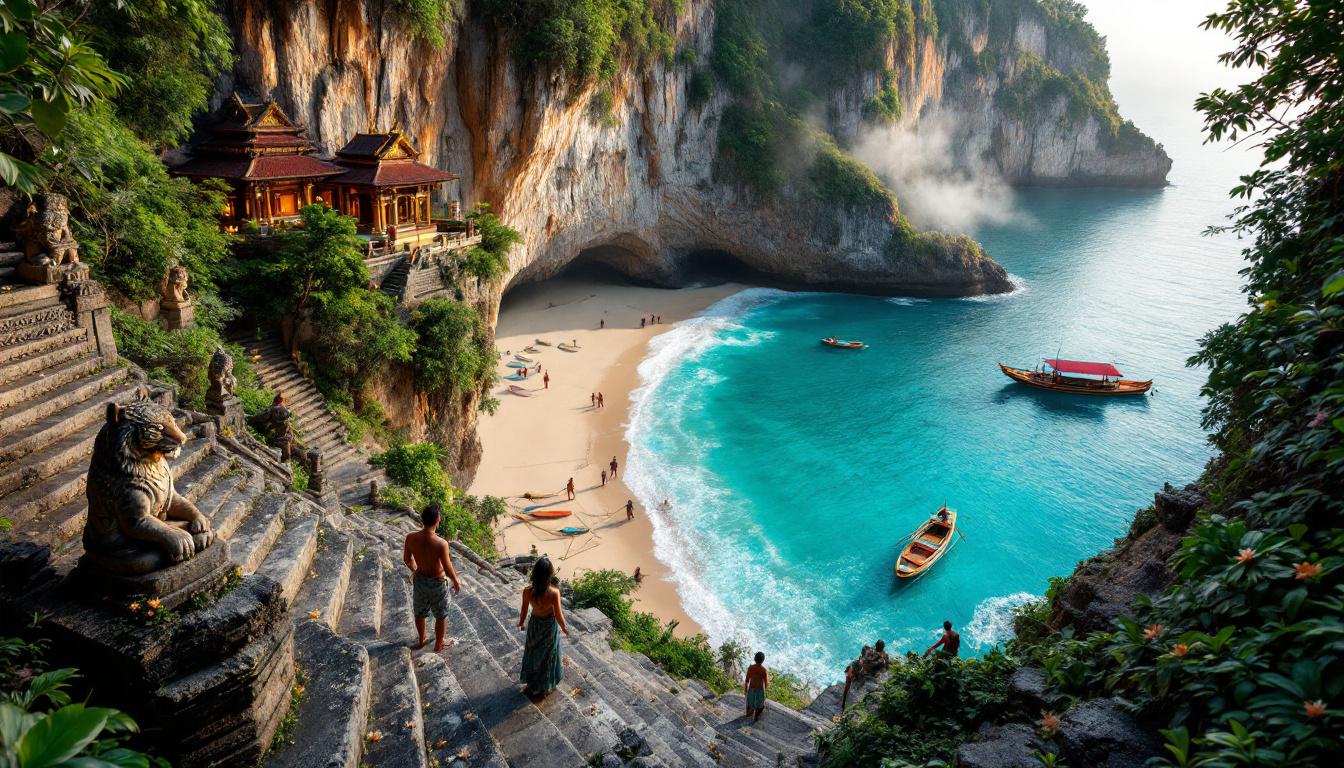Down 120 sacred stone steps carved into limestone cliffs, past temple guardians with amber eyes that seem to track every movement, lies the beach that Balinese elders pray foreign cruise lines never discover. Padang Padang Beach isn’t just another Bali postcard—it’s a 110-meter strip of white sand that local fishing families and temple priests actively protect from the tourism machine devouring their island.
While millions flock to overcrowded Kuta and commercialized Seminyak, this tiny sanctuary remains deliberately difficult to reach. The Hindu tiger statues guarding the cliff-top temple aren’t mere decoration—they represent centuries of spiritual protection that locals believe keeps mass tourism at bay.
What makes this place so fiercely guarded isn’t just its world-class surf break known as the “Balinese Pipeline.” It’s the delicate balance between ancient Balinese Hindu traditions and the modern world that threatens to overwhelm them.
The temple guardians who control beach access
Sacred gatekeepers maintain spiritual barriers
Every dawn, temple priests perform ceremonies at the cliff-top Pura overlooking Padang Padang, blessing the waters below and invoking protection for this sacred coastline. These “keepers of balance between the spiritual and natural worlds” aren’t tourism officials—they’re spiritual guardians whose families have protected these cliffs for generations.
Traditional fishing families resist development pressure
Local pemangku (temple caretakers) work alongside traditional fishing families who’ve used these waters for centuries. Their boats still launch at sunrise, following ancient lunar calendars rather than tourist schedules. They’ve watched neighboring beaches transform into concrete tourist strips and refuse to let Padang Padang follow the same path.
Why locals fear the cruise ship invasion
Sacred water beliefs clash with mass tourism
In Balinese Hindu tradition, ocean water carries spiritual energy that requires careful balance. Local ceremonies include melasti purification rituals where devotees carry sacred temple objects to the sea. Cruise ship passengers arriving in thousands would disrupt these ancient practices that locals consider essential for maintaining cosmic harmony.
Environmental protection through cultural preservation
The 75 families responsible for the area’s temple management have implemented subtle restrictions that maintain the beach’s exclusivity. Entrance fees help control numbers while funding environmental protection. The challenging 120-step descent through narrow limestone crevices naturally limits access to those truly committed to the journey.
The fishing community’s preservation strategies
Traditional boat schedules that tourists can’t predict
Local fishermen deliberately maintain unpredictable schedules tied to traditional Balinese calendar systems rather than tourist-friendly timetables. Their jukung outrigger boats launch during ceremonies and fishing seasons that follow ancient lunar patterns, making it impossible for tour operators to guarantee “authentic fishing experiences.”
Monkey guardians as natural crowd control
The resident macaque population serves as unexpected allies in limiting visitor numbers. These intelligent primates, considered sacred messengers in Hindu tradition, have learned to identify and discourage large tourist groups while tolerating respectful individual visitors who approach with proper cultural awareness.
How to visit respectfully without betraying local trust
Proper temple etiquette that locals appreciate
Arrive with a sarong and temple sash, bring small offerings of flowers or incense, and time your visit around traditional ceremonies rather than surf conditions. Local priests notice visitors who show genuine cultural respect versus those seeking Instagram opportunities.
Supporting community preservation efforts
Pay entrance fees without complaint, buy from local warungs rather than bringing outside food, and learn basic Balinese greetings. The fishing families who’ve protected this place for generations can immediately distinguish between respectful travelers and exploitative tourists.
As development pressure intensifies across Bali, places like Padang Padang represent something increasingly rare—authentic cultural landscapes where spiritual traditions still govern access to natural beauty. The temple guardians and fishing families aren’t trying to exclude visitors entirely.
They’re asking for something revolutionary in modern tourism: respect for the sacred systems that created the very authenticity travelers seek. Visit during the dry season when ceremonies are most frequent, approach with genuine cultural curiosity rather than social media agenda, and you might discover why locals consider this protection worth fighting for.
